Highly Recommended Award
Our Highly Recommended designation is earned by products offering extraordinary value or performance in their price class.
- Bright laser light image
- Full 48Gbps HDMI 2.1
- Dolby Vision support
- Dynamic tone mapping
- Great color tracking for BT.2020
- Excellent low latency for gaming
- Calibration quickly drifts
- Color shift due to laser dimming (EBL)
- EBL locks laser power
The Valerion VisionMaster Pro 2 is one of the higher-tier models in the VisionMaster lifestyle projector lineup, offered by AWOL’s sister company, Valerion. Generating significant buzz and excitement in the projection market, Valerion has crafted an impressive unit that stands out. It delivers a lot of performance at an excellent price, thanks to the inclusion of rare and generally well-performing features for a projector in this class and price range. This outstanding price-to-performance ratio makes it easy to see why the Valerion VisionMaster Pro 2 has garnered so much enthusiasm.
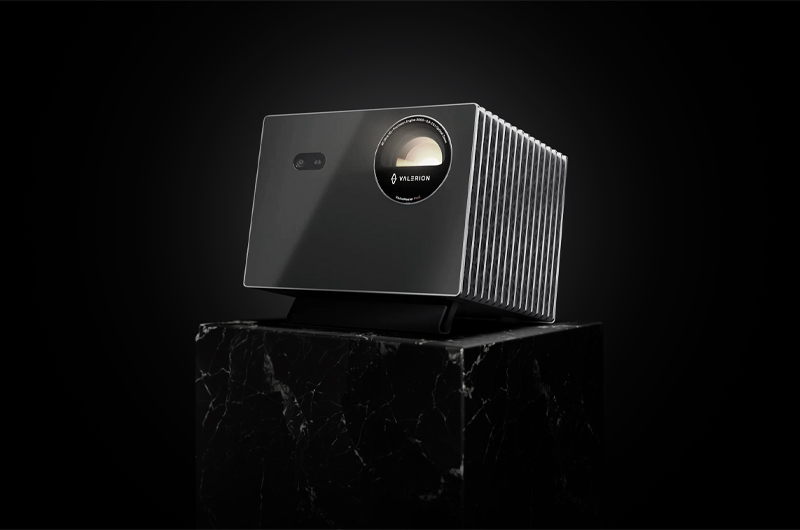
On October 10, 2024, Valerion launched a Kickstarter campaign that would soon become the highest funded projector in crowdfunding history and the most funded project of the year. This campaign introduced the VisionMaster line of projectors, allowing backers to choose from five models that Valerion was developing. With enticing price points, early supporters had the opportunity to secure a unit before the official release. Valerion quickly surpassed its funding goal and continued to unlock stretch goals, offering additional perks to prospective buyers throughout the campaign.
Among the models introduced was the VisionMaster Pro 2, second only to Valerion's Max flagship unit, which has yet to be released. The VisionMaster Pro 2 boasts an impressive array of features, many of which are rare in lifestyle projectors within its price range. Designed for a cinematic experience, it delivers high brightness, exceptional HDR performance, and a level of visual quality not typically seen in projectors of this class. Whether used as a primary projection system in a dedicated dark room, a multipurpose space, or as a portable lifestyle projector, the VisionMaster Pro 2 adapts to various viewing environments.
With its strong feature set, vibrant colors, and outstanding HDR performance, the VisionMaster Pro 2 stands out as a versatile and high-performing projector.
Insights into Our Reviewer's Process
Check out this interview with reviewer Sammie Prescott where we learn more about his background and projector review process and discuss his most recent review of the Valerion VisionMaster Pro 2.
Features
Released in late 2024 with an MSRP of $2,999, the Valerion VisionMaster Pro 2 generated significant excitement in the projection market with its impressive feature set and competitive pricing, offering exceptional price-to-performance value. The VisionMaster Pro 2 provides prospective buyers with 3,000 ISO lumens from its RGB triple-laser light source, impressive contrast, dynamic tone mapping, excellent gaming performance, and more.
The VisionMaster Pro 2 technically achieves—and even exceeds—its published specification of 3,000 ISO lumens when using the Brightness Enhancer mode on either Low or High. In this mode, the VisionMaster Pro 2 measured 3,383 ANSI lumens, surpassing Valerion's specification by 10.55%. However, this feature introduces a heavy green bias to the image and forces certain picture settings, such as color space, to Native while locking out critical adjustments like White Balance. As a result, it is not recommended for standard viewing.
When measuring the brightest picture mode, Standard, without Brightness Enhancer enabled, the VisionMaster Pro 2 recorded 2,503 ANSI lumens—approximately 17% below Valerion's published specification. However, this remains within the allowable limits of ISO 21118.
The VisionMaster Pro 2 employs a TI 0.47-inch DMD DLP chipset in combination with Valerion's RGB triple-laser light source, which boasts a lifespan of 25,000 hours, and the AI-SoC MT9618 platform. While the VisionMaster Pro 2 is not a native 4K projector, it can accept and resolve the full UHD 4K (3840x2180) resolution of 8.29 million pixels on-screen using pixel-shifting. The image it produces is incredibly sharp, delivering crisp and clear visuals.
During my time with the VisionMaster Pro 2, I noticed some mild rainbow effect, which was more pronounced in certain picture modes than in others. Users sensitive to this effect may prefer the Theater picture mode, as it appears to be less affected. Additionally, I experienced mild speckling on my StudioTek 130 G4 screen, which is not uncommon for higher-gain screens. I tested additional screen materials and observed varying results—though overall, the speckle effect was minimal, with some materials eliminating it entirely.
As previously mentioned, the VisionMaster Pro 2 projects an incredibly sharp image, thanks in part to its advanced processing and high-quality lens system. The projector's lens features a 0.9-1.5x optical zoom, which is a highly valuable addition. Optical zoom is somewhat uncommon in lifestyle projectors, so its inclusion here is particularly beneficial, as it provides greater installation flexibility. Many lifestyle projectors have very short throw distances, which can limit placement options, making this feature an excellent enhancement.
The focus on the VisionMaster Pro 2 is also very good. However, both the zoom and focus adjustments feel somewhat coarse, with relatively large incremental steps. That said, it remains incredibly easy to fine-tune and achieve a sharp, well-defined image.
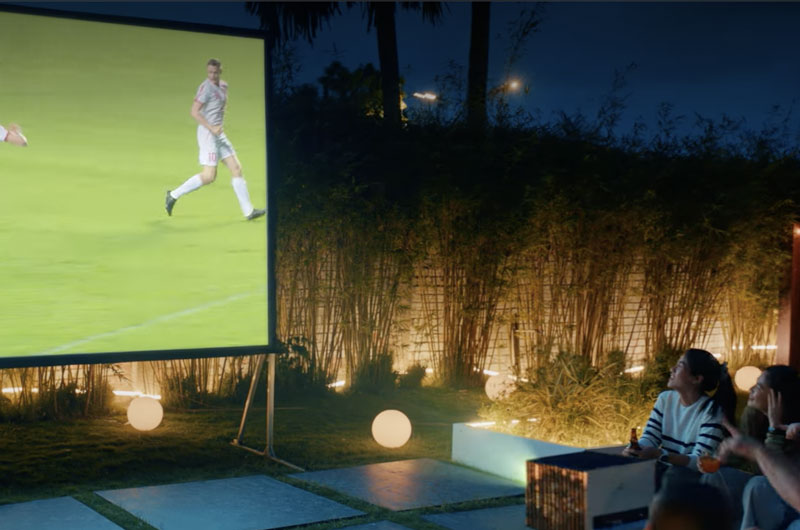
The most standout feature of the VisionMaster Pro 2 is its Enhanced Black Level (EBL) technology, which delivers impressive contrast ratios previously unseen in projectors of this class. Typically, most lifestyle projectors using a 0.47-inch DMD DLP chip have a native contrast ratio of 1,500-2,000:1, and the VisionMaster Pro 2 falls within this range. However, with the EBL feature enabled, the achievable contrast ratio jumps to an impressive 9,000-15,000:1, significantly enhancing image depth and delivering high-contrast scenes with remarkable clarity.
That said, the EBL feature does come with a notable drawback that some users may find difficult to overlook—a distinct color shift in the image. This shift is clearly visible and, in my experience, not subtle. Additionally, when transitioning from dark to bright scenes, the projector exhibits a slow ramp-up before stabilizing, which is also quite noticeable. Whether this is due to sample-to-sample variance, an implementation issue, or simply my own sensitivity to the effect, it is undeniably present and does somewhat diminish an otherwise excellent feature.
The VisionMaster Pro 2 also boasts outstanding gamut coverage of the Rec. 2020 color space. While Valerion's published specifications list it at 110% of Rec. 2020, our measurements showed that the VisionMaster Pro 2 covered 92.35% xy and 94.91% uv—an excellent result. Additionally, it demonstrated remarkable color mapping within Rec. 2020, not only for Rec. 2020 itself but also for P3 in 2020 and 709 in 2020. Most lifestyle projectors struggle to achieve this level of accuracy due to poor mapping or subpar control performance. In this regard, the VisionMaster Pro 2 exceeded my expectations.
The VisionMaster Pro 2 offers Dynamic Tone Mapping for HDR content, which is a welcome addition. While the Dynamic Tone Mapping performs well, it does not fully resolve details in higher-nit content, and some clipping is still visible. However, the fact that this feature is included—something relatively rare in this class of projector—is a significant advantage. It allows users to enjoy a generally pleasing image without needing to adjust settings to make HDR content more viewable, enabling a more seamless viewing experience.
In addition to Dynamic Tone Mapping, the VisionMaster Pro 2 supports both HDR10+ and Dolby Vision, providing users access to all major HDR formats. Both formats perform well overall, though some clipping is still present. Ultimately, the VisionMaster Pro 2 delivers an enjoyable viewing experience that many users will appreciate. Additionally, the VisionMaster Pro 2 offers support for a 48 Hz refresh rate, which is especially rare for many projectors in this class or in any class for that matter.
The VisionMaster Pro 2 is slightly heavier than most lifestyle projectors but remains highly portable due to its compact size and included carrying case. The extra weight is likely due to the electroplated metal strips around the unit's exterior, which are designed to withstand approximately 100 kilograms (220 pounds) of pressure. While this is an interesting design choice, the aesthetics may be divisive. The front of the unit is sleek, but the rear design is somewhat unusual. Although the back panel maintains a clean look when closed, it must remain open at all times because the power connector is located behind it. A more practical design would have exposed the power connection permanently rather than requiring a flap to stay open.
Weighing 15.4 pounds and measuring 10.2 x 7.3 x 8.5 inches (WHD), the VisionMaster Pro 2 can be set up almost anywhere, whether in a ceiling-mounted or tabletop configuration. Thanks to its optical zoom, it offers more flexibility than most competing models. With a 105% offset, users should plan accordingly for installation, particularly considering its short throw, to avoid placement obstructions. Capable of projecting an image from a 40-inch diagonal up to a massive 300-inch diagonal, the VisionMaster Pro 2 can accommodate a wide range of user needs, delivering a truly immersive cinematic experience.
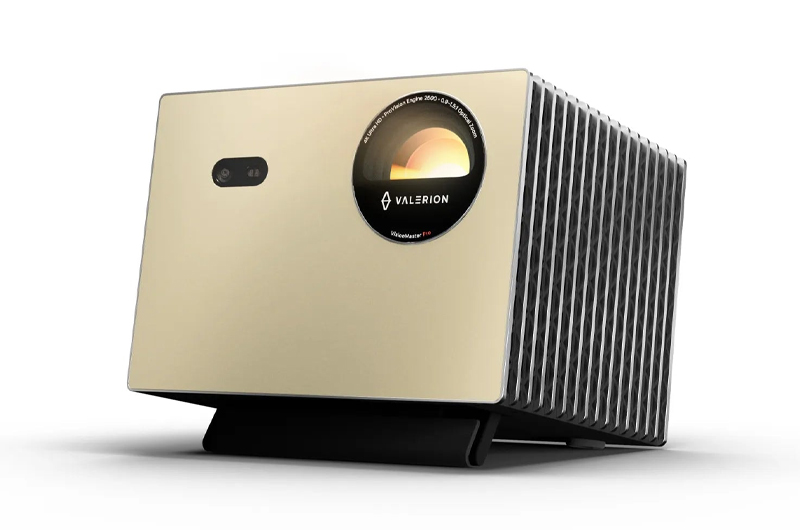
The VisionMaster Pro 2 features built-in 12W stereo speakers that deliver impressive sound quality with support for DTS:X and Dolby Atmos. The audio output is surprisingly full, making it suitable for use without an external sound system in temporary setups—a key advantage of its portable nature.
While the VisionMaster Pro 2 offers impressive output and customizable audio tuning through its seven-band equalizer, it is not a substitute for a dedicated sound system. Fortunately, it supports eARC, allowing uncompressed audio to be passed to an AVR, AVP, or soundbar for a more cinematic experience.
The VisionMaster Pro 2 runs on Google TV with Android TV OS 12. Android and Google TV are commonly used operating systems in many lifestyle projectors, offering a mature platform with a wide range of features. These include, but are not limited to, Chromecast, AirPlay, and screen mirroring. Users also have access to the Play Store, allowing them to download various apps in addition to the pre-installed ones for popular streaming services, including authorized Netflix, YouTube, Prime Video, Disney+, MAX, and more.
What stands out most about the VisionMaster Pro 2's implementation of Google TV is that it avoids many of the issues that plague other projectors using the same platform. For example, it provides independent dynamic range settings for SDR and HDR, ensuring proper adjustments for different content types. Additionally, it correctly detects color spaces and applies the appropriate one for content received via HDMI. However, the projector did display its smart platform apps in BT.2020 when set to Auto for color space selection, instead of using the correct color space, which resulted in heavy oversaturation.
Ultimately, the VisionMaster Pro 2 offers one of the best implementations of Google TV that I've tested in a projector of this class.
The VisionMaster Pro 2 is not a dedicated gaming projector; however, that did not stop our sample of this Valerion model from delivering performance comparable to that of a dedicated gaming projector. It features a Game Bar, providing quick access to various gaming-related settings, such as enabling Dark Detail, Instant Game Response, and High Refresh Rate Mode.
The input latency is impressive, with published specifications of 4ms at 1080p/240Hz, 8ms at 1080p/120Hz, and 15ms at 4K/60Hz. Our measurements found these numbers to be mostly accurate. Using a Murideo Seven G 8K, we measured the latency and obtained the following results:
4K/60 = 35ms (no Instant Game Response or HRRM/DLP Turbo)
1080p/60 = 35ms (no Instant Game Response or HRRM/DLP Turbo)
4K/60 high refresh rate mode/DLP Turbo = 27ms
1080p/60 high refresh rate mode/DLP Turbo = 18ms
4K/120 high refresh rate mode/DLP Turbo = 10ms
1080p/120 high refresh rate mode/DLP Turbo = 10ms
1080p/240 high refresh rate mode/DLP Turbo = 5ms
These values can be achieved in any picture mode, as High Refresh Rate Mode, DLP Turbo, and Instant Game Response can be utilized regardless of the selected mode. Additionally, DLP Turbo and High Refresh Rate Mode function similarly—either can be used independently, or both can be enabled simultaneously. Any combination of these settings will result in the same level of latency.
During game latency testing, our sample of the VisionMaster Pro 2 performed some level of processing even when all picture enhancements are disabled. However, enabling DLP Turbo or High Refresh Rate Mode caused a noticeable softening of the image. When Instant Game Response was then activated, the picture became slightly sharper but introduced distinct jagged edges. In gaming scenarios, this may not be an issue due to anti-aliasing, which would smooth out the image. However, the effect was noticeable enough that I wouldn't recommend keeping these features enabled for all types of content unless actively playing a game.

The VisionMaster Pro 2's I/O includes three HDMI ports, two of which are full-bandwidth 48Gbps ports with 12G @ 4L for FRL, making the VisionMaster Pro 2 a true HDMI 2.1 device. Many lifestyle projectors claim HDMI 2.1 support due to features like eARC, benefiting from the relaxed nature of the HDMI 2.1 specification. However, they rarely include full-bandwidth ports. The third HDMI port on the VisionMaster Pro 2 is an HDMI 2.0 port with eARC support.
The projector also features two USB ports—one USB 3.0 Type-A and one USB 2.0 Type-A—both supporting media playback and power delivery. Additional connectivity options include an RJ-45 network port, an SPDIF optical audio output, and a 3.5mm headphone jack.
The included remote is highly responsive and provides access to all essential controls, allowing users to navigate the VisionMaster Pro 2 with ease. It includes quick-access buttons for popular built-in streaming apps, voice control, autofocus, and even an AI button for accessing various AI-driven features such as AI Scene. Lastly, the VisionMaster Pro 2 supports 3D playback, making it a great option for 3D enthusiasts.
Performance
Color Modes. The VisionMaster Pro 2 offers an impressive array of picture modes, all of which can be configured independently to suit a viewer's preferences. There are seven picture modes available for SDR, eight for HDR, three for Dolby Vision, and four for HDR10+. These modes generally follow the same naming conventions with slight variations.
For SDR, the available picture modes include Vivid, Standard, Sports, PC/Game, Energy Saving, Theater, and Filmmaker. HDR10 uses the same names with an "HDR" prefix, though "PC/Game" is renamed to "HDR Game," and an additional "IMAX Enhanced" mode is included. HDR10+ follows a similar pattern, using the "HDR10+" prefix and offering Vivid, Game, Standard, and Theater. Dolby Vision, on the other hand, provides Bright, Dark, and Custom picture modes.
With this extensive selection, users have more than enough options to fine-tune the picture to their liking. Thanks to independent memory settings for SDR, HDR, HDR10+, and Dolby Vision, the projector automatically applies the correct settings based on the content's dynamic range. This very welcome and good to see as many lifestyle projectors share settings across picture modes regardless of dynamic range. The VisionMaster Pro 2 eliminates this issue, allowing users to set up dedicated picture modes for SDR and HDR that switch seamlessly without requiring manual input.
The projector also offers a comprehensive suite of calibration controls. Users can adjust standard picture settings such as Contrast, Black Level, Color, Hue, and Sharpness. Additionally, advanced controls include Offset and Gain settings, 20-point White Balance adjustments, and Gamma controls. A full Color Management System (CMS) is also available, allowing precise tuning of Hue, Saturation, and Luminance for both primary and secondary colors.
The VisionMaster Pro 2 features four gamma presets: 2.0, 2.2, 2.4, and BT.1886. These gamma values track extremely accurately to their designated settings—for instance, selecting 2.2 results in an exact 2.2 gamma. This level of precision is impressive, as the gamma was very flat and required little to no adjustment. However, for users who require further fine-tuning, a 20-point gamma adjustment option is available.
Out of the box, our sample of the VisionMaster Pro 2 performed well, although the white point needed to be adjusted as it leaned more toward green. It was not overly offensive though was noticeable. Most picture modes behaved similarly depending on the color temperature used as the default as well as the Color Space associated with the picture mode as some used Native, others used BT2020, some used Warm 1, Cool, etc. Ultimately all picture modes can be set to look essentially identical. Using Theater or Filmmaker with Warm 1 was the best starting point for a relatively accurate image. In our review sample I did notice that blue and, in some instances, cyan was a little too dark. Everything else generally looked good.
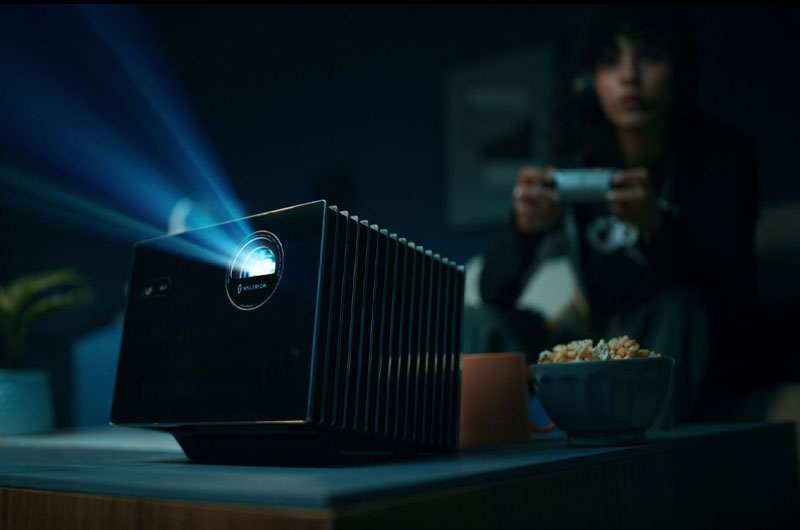
At this point I began using the Enhanced Black Level (EBL) which was very impressive at first glance as it provided great contrast to the image displaying great depth. I did unfortunately start to notice a color shift when going between content and test images. It became very apparent when returning to images I had viewed prior, which initially looked good now showed a mild to heavy green bias to the image.
I noticed two things in particular. One was that when EBL was activated and the projector returned to a brighter scene, a slow transition would occur where a very strong color change would happen before it stabilized. The next thing I noticed was that each time the unit would go back to the brighter image after the slow transition, it always had either a green or red dominant shift to the image. I continued to go through various content and test images, and this was consistent in behavior, measurable, and visible to the eye. Some users may not see this, just as some users cannot see the rainbow effect. I unfortunately can see this very easily, which is a disappointment because it was quite distracting.
For OOTB viewing the ideal picture modes for SDR and HDR was either Theater or Filmmaker with Warm 1 for the color temperature. If a user sees the image as being two green, the viewer may want to consider lowering the Gain control for green. However, again it is important to note that if using EBL some of the green color shift that is seen may be due to the constant color shift caused by this feature, in which case EBL would need to be deactivated.
I calibrated the VisionMaster Pro 2 with Calman Ultimate calibration software from Portrait Displays, a 1nm Qalif Spectro, Colorimetry Research CR-250 Colorimeter, Colorimetry Research CR-100 Colorimeter, and a Murideo 8K Seven Generator. The VisionMaster Pro 2 was calibrated to a 100-inch diagonal screen size on a Stewart Filmscreen StudioTek 130 G4 projection screen. I ran my normal measurements to confirm what I saw in OOTB viewing prior to calibration.
The pre-calibration measurements for the VisionMaster Pro 2 showed somewhat higher dE errors OOTB using the Theater picture mode. (DeltaE is the metric used to determine visible errors. It has been determined that anything over a dE of 3 is visible, anything over 2.3 is a just noticeable difference for trained eyes and anything below 2.3 should ideally not be seen to the eye.) Average readings for SDR were in the range of approximately 3dE, with maximum errors reaching up to 7.8 dE. Grayscale averages were 3.7dE with a max of 6.6dE, 5% saturation sweeps averaged 2.7dE with a Max of 7.8dE, and large-scale Color Checker averaged 2.4dE with a max of 6.8dE. HDR averaged 5.2dE and a max of 9.6dE, though much higher in ITP due to the lack of luminance which is typical of projectors.
The VisionMaster Pro 2's gamut coverage measured 98.6% xy and 99.2% uv for DCI-P3, while BT.2020 coverage measured 92.35% xy and 94.91% uv. This is excellent performance and shows the benefit of RGB triple laser light sources, allowing projectors to cover nearly all of the BT.2020 gamut without the need to rely on a such things as filters to expand gamut coverage. This ultimately allows viewers to take full advantage of their usable light, while achieving impressive gamut coverage. The VisionMaster Pro 2's native contrast ratio measured approximately 1,733:1 FOFO (full-on, full-off), with Min throw and EBL activated contrast measured 9,724:1 FOFO, and at Max throw 14,857:1 FOFO which is very close to Valerion's specification of 15,000:1.
I targeted the industry-standard D65 neutral gray white point using the Gain controls, and utilized the full CMS controls for calibration.
The post-calibration DeltaE errors improved for both SDR and HDR. In Theater picture mode for SDR, the final grayscale average was 1.1 dE, with a maximum of 2.9 dE. The color gamut had an average DeltaE of 1.5, with a maximum of 2.5dE. A large 150+ patch Color Checker, which tests swatches representing different skin tones, blue sky, etc., measured an average of 1dE with a maximum of 3.9 dE. Saturation sweeps at 5% increments showed an average of 1.3dE and a maximum of 3.4dE.
Post-calibration HDR results, using the HDR Theater picture mode, showed an average of 3.6dE for grayscale and 5.4dE for gamut saturation sweeps for BT.2020.dE. The VisionMaster Pro 2 is actually the most accurate lifestyle projector that I've tested in regards to BT.2020.
I did observe several issues that resulted in larger errors in luminance sweeps. The VisionMaster Pro 2 desaturates red and blue quite heavily at low luminance; red tends to desaturate anything at 10% stimulus and below while blue desaturates anything below approximately 20% stimulus. All other colors desaturated up to just under 5-7% stimulus.
Additionally, on my review sample blue and cyan showed slight deviation in saturation tracking due to hue when viewing measurements in 5% increments. It was not too bad but was noticeable. The only other issue I saw was that the calibration of the unit drifted very quickly, much quicker than I have seen in other projectors.
The devices I used for reviewing content post calibration were an R_Volution Player One 8K media player, Oppo UDP-203 Blu-ray player, and an AppleTV 4K.
1080p/SDR. On the first movie I watched, Gravity, the visuals looked great, and motion handling was impressive. However, the main issue was the visible rainbow effect, particularly on the slow-moving shuttle as it entered the scene. Even slight eye movements across the screen revealed this effect, which was actually more pronounced at various color temperatures.
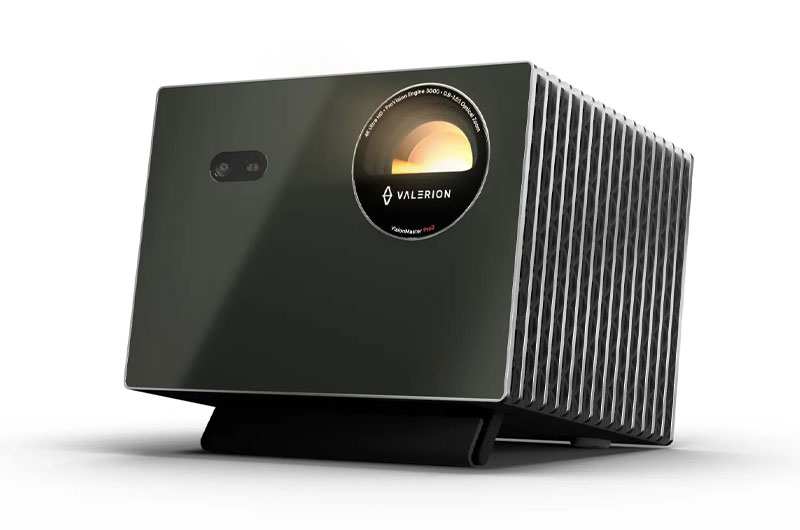
As the scene unfolded—following the debris strike on the shuttle—Sandra Bullock's character released the belt securing her to the spinning arm drifting into space. As the arm moved off-camera and she became smaller, the EBL (Enhanced Black Level) feature activated, causing the letterbox bars and the scene itself to darken. This was noticeable due to the frame of the scene. In most cases, I do not think most would notice this while viewing content, but might be seen on occasion.
4K/HDR10/DolbyVision. The next content I decided to watch was the Spears & Munsil HDR Benchmark Disc, Volume 4. I viewed several test patterns and sample content, starting with the Starfield patterns. These patterns feature a black circle in the center of the screen, surrounded by a starfield that gradually increases in density.
With EBL turned off, the transition between each starfield set was more distinct, whereas enabling EBL produced smoother transitions by dimming at a set point, ensuring that new stars appeared consistently in terms of black floor levels. Occasionally, a large yellow "S&M" would move across the screen, increasing the average picture level (APL). Once the logo became small enough, EBL activated, causing the screen to dim.
Next, I examined single-pixel behavior. With EBL off, transitioning from a fully black screen to a single pixel slightly raised the black floor. However, with EBL set to either Low or High, the black floor remained intact. Switching from a black screen to a full-colored or white screen caused a slow color shift as the image brightened; this was very visible but would stabilize. However, the color shift would remain and be visible to the eye depending on the content being viewed. This usually was presented with a green or red hue.
I then moved on to demo content, including the montage and skin tone tests. Skin tones appeared natural and accurate for all the individuals shown.
Finally, I watched the montage in HDR10 at 1,000, 2,000, and 10,000 nits, as well as in 10,000-nit Dolby Vision. All content was presented without noticeable banding or posterization in areas where these issues could typically arise. The colors were vibrant and the image was overall pleasing. However, there was some clipping in various scenes. The 1,000-nit content exhibited minimal clipping and was displayed as expected. However, the 2,000-nit and 10,000-nit content suffered from more noticeable clipping, particularly in scenes like the horses in the snow, where details could not be fully resolved. While it did not look bad, the clipping was apparent.
4K/HDR10. Next, I watched Mad Max: Fury Road during the sandstorm scene. The movie looked impressive, with bright highlights and excellent color saturation, particularly in the distant fire. However, some clipping was noticeable in the clouds, sun, and explosions. Despite this, the explosions remained highly saturated, though clipped. Lightning strikes also appeared with intensely bright highlights.
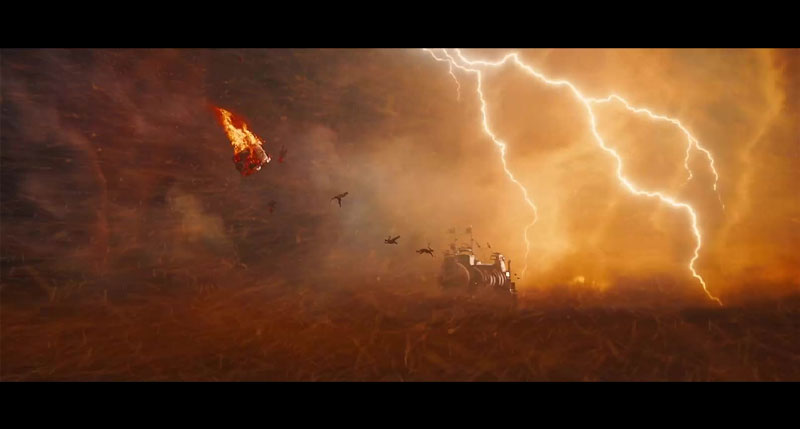
Overall, the image quality was strong, as the Valerion maintained a high saturation, and a bright picture with great highlights throughout the movie, delivering an engaging visual experience. However, I did notice occasional glimpses of the rainbow effect on various objects during certain scenes that had extremely bright highlights, but it was very minor.
The last movie I watched was the beginning of Black Panther. The image quality was quite good, with impressive black levels. This scene can be challenging for many projectors, as it often appears either slightly washed out and milky or overly dark, making details difficult to see. However, the Valerion performed exceptionally well, rendering detail without appearing washed out while maintaining a solid black floor without crushing the finer details.
Have a Projector Question?
Join our free ProjectorCentral Facebook Group to get answers quickly.
Check it Out
The few glimpses of color in the scene, such as the light flashing on the barking dog, were well-represented. Once T'Challa returned to Wakanda and began his first challenge, skin tones appeared accurate, and the outfits were vibrant and colorful. The Valerion handled this movie exceptionally well, with many scenes standing out, particularly when T'Challa visited the ancestral plane.
Conclusion
The VisionMaster Pro 2 is an excellent projector, and it is easy to see why so many users enjoy it. Its level of performance is rare for a projector in this class and price range. In many aspects, it outperforms its peers, making it a compelling option for those new to projection or looking for an upgrade. It is arguably one of the best, if not the best, lifestyle projectors currently available. That's not to say it is without flaws or areas for improvement, but overall, it performs exceptionally well compared to most projectors in its category.
What sets the VisionMaster Pro 2 apart is its inclusion of Enhanced Black Level, a feature uncommon in lifestyle projectors. Additionally, it offers an optical zoom, which is a rarity, as most lifestyle projectors have fixed lenses. This provides added flexibility in installation, even though the projector still has a very short throw. Moreover, it offered some of the most accurate BT.2020 mapping of any lifestyle projector that I have tested. Unlike many competitors, the VisionMaster Pro 2 also avoids the common quirks related to picture modes, color spaces, and overall functionality, making it significantly more functional.
For gamers, the VisionMaster Pro 2 delivers excellent performance, with latency that rivals or even surpasses some dedicated gaming projectors. It also excels in HDR performance, supporting Dynamic Tone Mapping, HDR10+, and Dolby Vision, ensuring it can accommodate a variety of content.
Among its many features, Enhanced Black Level is perhaps the most notable—and for good reason, as it performs well in providing greater contrast. However, some users may choose not to use it due to the aggressive visible color shift it introduces, which I unfortunately was able to see very easily. This is unfortunate, as without EBL, the VisionMaster Pro 2 aligns more closely with other projectors in its class—though it still excels in several other areas.
The projector could benefit from refinements, particularly in its zoom and focus adjustments, as the steps are too large. Additionally, I would like to see improvements in calibration drift, which should be slower and less pronounced. Some minor issues also need addressing, such as the high-altitude warning message that appears when EBL is activated and a user attempts to change laser power. Preferably this restriction would be removed and laser power could be adjustable with EBL engaged. Lastly improvements to the Dynamic Tone Mapping would greatly improve the overall performance of the VisionMaster Pro 2 as clipping was very apparent in content.
Ultimately, the VisionMaster Pro 2 is an excellent projector that delivers great performance. Whether as a primary or companion projector, it is a strong choice, thanks to its high light output and versatility. As long as users can accommodate its throw requirements, it will perform effectively in nearly any type of room, making it a strong option for many.
Measurements
Brightness. The Valerion VisionMaster Pro 2 is rated for 3,000 ISO lumens. The brightest picture mode is Standard using Brightness Enhancer which measured 3,354 lumens using the 9-point averaged measurement defined in the ISO and recently retired ANSI standards. That result is almost 10.55% higher than Valerion's listed specification. However, this picture mode is not suitable for viewing content due to its heavy green bias. Standard without Brightness Enhancer enabled measured 2,503 ANSI lumens which is approximately 16.6% below Valerion's listed specification, though within the 20% allowable tolerance of the ISO21118 specification.
VALERION VISIONMASTER PRO 2 ANSI Lumens
| SDR/HDR Modes | LD POWER 100 |
|---|---|
| Standard (Brightness Enhancer) | 3,383 |
| Vivid | 2,497 |
| Standard | 2,503 |
| Sports | 2,478 |
| PC/Game | 2,470 |
| Energy Saving | 2,495 |
| Theater | 2,131 |
| Filmmaker Mode | 2,131 |
| HDR Vivid | 2,067 |
| HDR Standard | 2,165 |
| HDR Sports | 2,165 |
| HDR PC/Game | 2,073 |
| HDR Energy Saving | 2,165 |
| HDR Theater | 2,167 |
| HDR Filmmaker Mode | 2,215 |
| IMAX Mode | 2,233 |
Zoom Lens Light Loss. The VisionMaster Pro 2's light loss when shifting from the widest zoom position to its longest telephoto position was 6.2%.
Brightness Uniformity. The Valerion VisionMaster Pro 2 projecting a 100-inch diagonal image resulted in measured brightness uniformity of 93% while in both wide-angle zoom and telephoto zoom. The brightest portion of the screen was the middle center with the dimmest being the right center. The difference in brightness on a full white screen was not noticeable.
Fan Noise. Valerion rates the fan noise at 28dB in normal operation. Using Room EQ Wizard software and a Umik-1 microphone, my theater room ambient noise floor is 33.3 dBA. The VisionMaster Pro 2 measured at the following dB in the following laser power settings at a distance of three feet.
Normal 100% laser
Rear: 35 dbA
Left: 34.1 dbA
Right: 34.7 dbA
Front: 34.5 dbA
Input Lag. Input lag measurements were done using the Instant Game Response and High Refresh Rate Mode.
4k/60 = 35ms
1080p/60 = 35ms
4k/60 high refresh rate mode/DLP Turbo = 27ms
1080p/60 high refresh rate mode/DLP Turbo = 18ms
4k/120 high refresh rate mode/DLP Turbo = 10ms
1080p/120 high refresh rate mode/DLP Turbo = 10ms
1080p/240 high refresh rate mode/DLP Turbo = 5ms
Connections
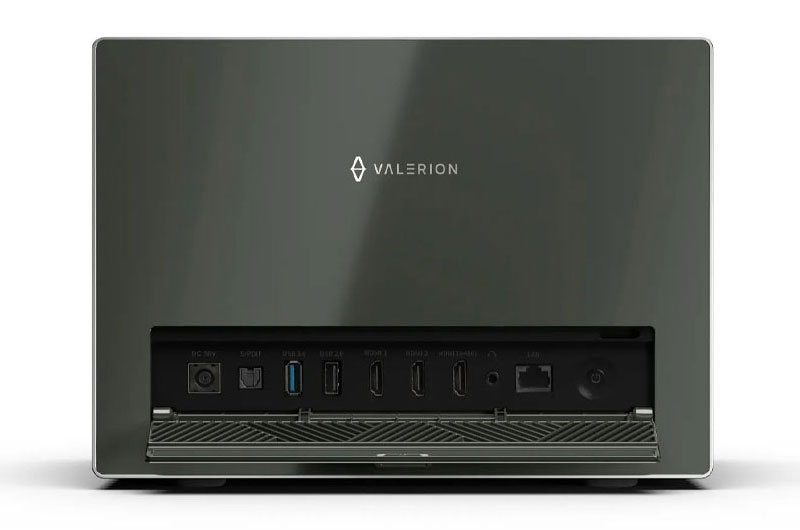
- HDMI 2.1 (x2; HDCP 2.3; 48Gbps FRL: 12G@4L)
- HDMI 2.0 (x1; HDCP 2.3; eARC HDMI 3)
- RJ45 LAN 100 base Tx (control only)
- USB 3.0 Type A (power delivery; media playback)
- USB 2.0 Type A (power delivery; media playback)
- SPDIF optical audio
- 3.5mm headphone jack
- Wi-Fi 6e
- Bluetooth 5.2
Final Settings
Calibrated image settings from any third-party do not account for the significant potential for sample-to-sample variation, nor the different screen sizes and materials, lighting, lamp usage, or other environmental factors that can affect image quality. Projectors should always be calibrated in the user's own space and tuned for the expected viewing conditions. However, the settings provided here may be a helpful starting point for some. Always record your current settings before making adjustments so you can return to them as desired. Refer to the Performance section for some context for each calibration.
SDR Settings
Picture Mode: Theater
General
Laser Luminance: 2
Enhanced Black Level: Off or High
Contrast: 40
Black Level 0
Dark Detail: Off
Gamma: 2.4 or 2.2 (room dependent)
Active Contrast: Off
Brightness Enhancer: Off
Color
Color: 50
Hue: 0
Color Temperature: Warm 1
Color Space: Auto
Dynamic Color Enhancer: Off
Clarity
Sharpness: 2
Smooth Gradient: Low
Super Resolution: Off
Noise Reduction: Off
MPEG Noise Reduction: Off
Motion Enhancement: Off
Calibration Settings
Color Tuner
| Color | Hue | Saturation | Brightness |
|---|---|---|---|
| Red | 0 | 1 | -1 |
| Green | 0 | 0 | 0 |
| Blue | 7 | -1 | 2 |
| Yellow | 0 | 0 | 0 |
| Cyan | -2 | 0 | 3 |
| Magenta | 0 | -1 | 4 |
| Flesh Tone | 0 | 0 | 0 |
White Balance
2-Point
R-Offset: 0
G-Offset: 0
B-Offset: 0
R-Gain: -3
G-Gain: -2
B-Gain: -5
If image is too green, the below adjustment may work better
White Balance
R-Offset: 0
G-Offset: 0
B-Offset: 0
R-Gain: -3
G-Gain: -10
B-Gain: 7
HDR Settings
Picture Mode: HDR Theater
General
Laser Luminance: 7
Enhanced Black Level: Off or High
Contrast: 45
Black Level 0
Dark Detail: Off
Gamma: ST2084
Active Contrast: Off
Brightness Enhancer: Off
Dynamic Tone Mapping: On
Color
Color: 50
Hue: 0
Color Temperature: Warm 1
Color Space: Auto
Dynamic Color Enhancer: Off
Clarity
Sharpness: 0
Smooth Gradient: Low
Super Resolution: Off
Noise Reduction: Off
MPEG Noise Reduction: Off
Motion Enhancement: Off
Calibration Settings
Color Tuner
| Color | Hue | Saturation | Brightness |
|---|---|---|---|
| Red | 2 | 6 | 0 |
| Green | 0 | 8 | 7 |
| Blue | 4 | 6 | 5 |
| Yellow | 0 | 9 | 12 |
| Cyan | -2 | 6 | 0 |
| Magenta | 0 | -1 | 5 |
| Flesh Tone | 0 | 0 | 0 |
White Balance
2-Point
R-Offset: 0
G-Offset: 0
B-Offset: 0
R-Gain: 0
G-Gain: -4
B-Gain: -12
For more detailed specifications and connections, check out our Valerion VisionMaster Pro 2 projector page.
To buy this projector, use Where to Buy online, or get a price quote by email direct from Projector Central authorized dealers using our E-Z Quote tool.
To clarify, we use the term "our sample" simply to imply that our results are based on reviewing the performance of that projector we were sent for review. That "sample" is typically a shipping product or at worst a "pre-production" sample sent right before wide availability. We never review a projector during a Kickstarter, as we feel too much is still in flux in terms of final tech. This particular projector was a shipping model provided two months after the Kickstarter campaign ended. Sammie factory reset the unit and received the latest firmware unit prior to running it through the paces and calibrating it as described.
Hopefully this can prove to competitors that you can fit all these features in a projector that isn't massive in both size and price. Hopefully the others can now step up their game as well as we haven't seen a great new compelling projector in this price range in over 5 years that isn't short throw.







